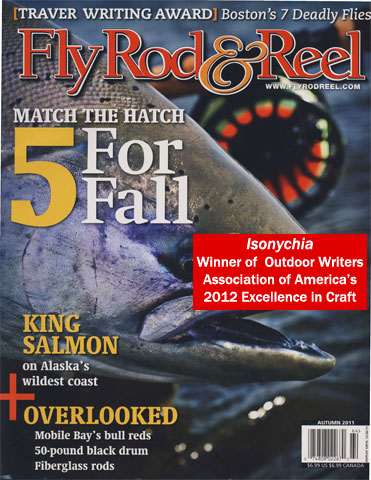Over the years I’ve found brilliance in events that don’t go according to plan.
That was the case last fall when I visited the Farmington River and saw anglers in every spot I wanted to fish. I had to laugh; Indian Summer was in full swing with its warm days and cool nights, the maples were turning scarlet and orange, the white birch were a colorful yellow, and trout were on the feed. Why wouldn’t the river be crowded?
At the bottom of a pool below a feeder stream was a gravel bar that allowed safe passage across the river and my only chance for some solitude. Safely across, I could wade upriver and fish the back side of an overlooked mid-river island.
About halfway up the island was some pocket water. It necked down into a small, shallow riffle that turned into a pool. The pool bent toward shore and cut under a bank. It bounced off some big rocks at the bottom and was a beautiful piece of water, all rolled into a 30-yard stretch.
Shortly, I saw a good brown perform a splashy rise near one of those rocks. Then another, and another. I inspected those rocks, and saw the shucks that explained those rises. Isonychia!
The first time I encountered these rich, eggplant-colored bugs, which are commonly called mahogany duns or slate-wing duns, I spent an entirely frustrating day changing from emergers to a wide variety of dries to a slew of nymphs with no luck. It was only during the final minutes of the day, when I botched a cast that put a lot of drag in my drift and fast motion to the fly, that a big brown whacked that speeding nymph. Since that time I’ve always used a fast swing when fishing this hatch, and it’s served well.
Here’s why that tactic works: Isonychia swim almost as fast as a dace and they climb on structure like a stonefly to shed their nymphal shucks–basically Isonychia duns are unavailable to trout and, therefore, it’s almost futile to fish a dry fly when an emergence occurs. But trout do chase down those fast-swimming nymphs, which I match with a size 12 or 14 Didas’ Swimming Isonychia Nymph.
While those duns aren’t important to trout, the Isonychia spinner is. It occurs most often in riffled water and can be matched by several noted patterns, including the White-Gloved Howdy, an lsonychia Comparadun, or a Beck’s Emerger-lsonychia. In contrast to fishing an Isonychia nymph, when fishing a spinner you’ll want to employ a dead drift.
There are two versions of Isonychia in the fall, the larger bicolor and the smaller sadleri. The hatch occurs on many Eastern, Midwestern and some Southern tailwaters and freestone streams, including emergences on such noted waters as Connecticut’s Housatonic River and Michigan’s Ausable. Wherever it occurs, the hatch typically comes off in early afternoon and lasts into dark-graciously, there’s no need to set the alarm clock earlv for this one.
Because Isonychia nymphs swim quickly you can forgo some of the extreme technical fishing required to match other fall hatches; you know, those painful experiences that require magnifying glasses and 8X tippet. Instead, you can throw a variety of classic patterns, such as the Leadwing Coachman, a Zug Bug or even a Pheasant Tail Nymph. My favorite pattern is Tim Didas’ aforementioned Swimming Isonychia Nymph. Didas spins the bug on a swimming nymph hook, adding a component that lights up the fish.
Looking back, it wasn’t so bad getting displaced by those other anglers on the Farmington. Browns and a few rainbows rose for hours, I had a quiet stretch of river to myself, and I was in the middle of a hatch that didn’t require much precision or stealth. I waited until the sun was long gone before I quit the stream, knowing I’d be back the next day.
Best Bets
Delaware and Beaverkill rivers, NY Connecticut River, NH Deerfield River, MA Penn’s Creek and the Little Juniata, PA Davidson River, NC Manistee and Ausable rivers, MI Hiwassee and Little rivers, TN
Didas’ Swimming Isonychia
Hook: Tiemco TMC400T, size 12 to 14 Thread: Burgundy 8/0 Tail: Three partridge after shafts Body: Burgundy dubbing Rib: Fine gold wire Thorax: Peacock herl Dorsal stripe: White Flexi Floss Wing case: Gray hen hackle Legs: Partridge

